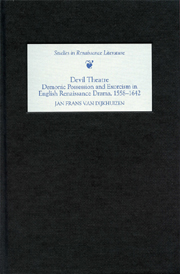INTRODUCTION
Published online by Cambridge University Press: 12 September 2012
Summary
In February 1594, the nine-year-old Anne Starkie, from Cleworth, Lancashire, began to suffer from violent contortions. A week later, her brother John fell ill too, and had lengthy fits of shouting. After several weeks, their father, Nicholas Starkie, asked Edmund Hartley, a local cunning man, to cure them. After their treatment by Hartley, Anne and John's seizures subsided, and they continued to be well for almost a year and a half. During this period they were regularly visited by Hartley. The children's fits returned, however, and became even more intense. They barked and howled, emitted stinking breath, and abused the family. They refused to eat or drink, suffered from fearful visions, and their bodies were cast violently about. Convinced that the children in his house were possessed by the devil, Nicholas Starkie contacted the Puritan preacher John Darrel, a clergyman from Ashby-de-la-Zouch, Leicestershire. Darrel was well known for the exorcisms he had performed in the mid-1580s and 1590s. It was his recent successful dispossession of Thomas Darling in Derbyshire which incited Nicholas Starkie to consult him. Shortly after his arrival, Darrel writes in his account of the events, the children became ‘strangely and grevously tormented,’ with their faces disfigured into grimaces, and their bodies unnaturally swollen. Darrel, his assistant George More, and a third preacher named Dickens, attempted to exorcise the children by means of fasting, prayer and the recitation of passages from the Bible.
- Type
- Chapter
- Information
- Devil TheatreDemonic Possession and Exorcism in English Renaissance Drama, 1558–1642, pp. 1 - 24Publisher: Boydell & BrewerPrint publication year: 2007



